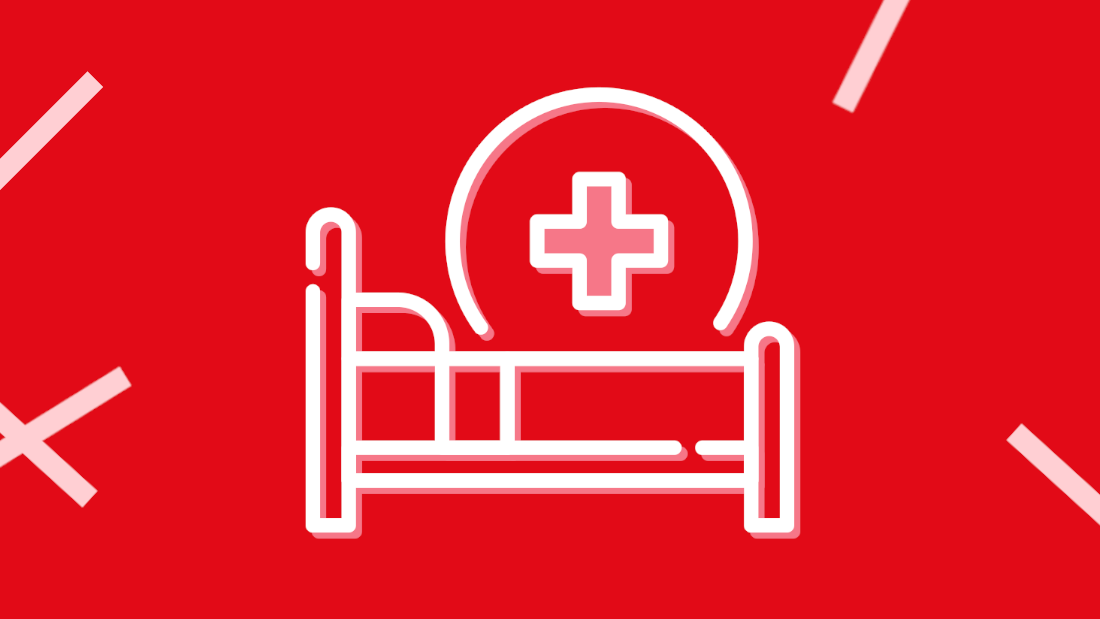Virtual hospital wards are a great example of how technology gives us more options to help healthcare service users. But how do we design them well?
‘Virtual wards’ is a bit of a buzz phrase. It describes an approach to for caring for patients in their homes rather than in hospital, while replicating to some degree the attention they might get in a clinical setting.
That means providing things like:
- 24-hour access to carers
- online ‘ward rounds’
- monitoring via online devices
- home visits
Picture a patient at home monitoring their own blood pressure, heart rate, pulse oximetry, mobility, and various other things.
It also reflects the realisation that there are loads of patients who are in a hospital ward just for ‘monitoring’.
That is, ongoing observation of their basic vitals to make sure they’re either ready for more substantial treatment or recovering well.
They often don’t need much direct care from moment to moment and aren’t at risk of crash-and-die trauma. So, their physical bed could be much better used.
The online world of 2024
A few years ago, all of this would have seemed either fanciful, or revolutionary. But two things happened.
First, the use of smartphones, laptops and affordable internet-enabled gadgets expanded massively. The most recent figures from the Office for National Statistics from 2020 show that 96% of UK households have internet access, up from 56% in 2006.
Secondly, the pandemic and COVID-19 changed the landscape for healthcare, as it did in many aspects of life.
For one thing, most of us found our homes become clinical settings. We administered lateral flow tests to ourselves and family members, and even turned spare bedrooms into makeshift isolation wards.
We got used to the idea that clinical care could be delivered over the phone or using video calling – an option many of us have come to value alongside in-person consultations.
The pandemic forced us all to engage in the reality of NHS resourcing. We were confronted with the reality of the pressure on hospitals, especially during winter. And we learned that hospitals aren’t always the best place for vulnerable people to be.
The user-centred design perspective
As a user-centred designer, the big question is: what are the user needs that virtual wards are addressing?
Critics of the idea argue that it is not drive by user needs but by political pressures. Politicians and administrators have a strong incentive to reduce the number of hospital beds occupied.
It’s about fudging the numbers, they say, and puts a burden on individuals and their families, while reducing the overall quality of care.
These critics ask: where is the evidence base?
There are plenty of arguments for how virtual wards benefit service users, however, even if they still feel somewhat anecdotal.
They include:
- lower risk of hospital-acquired infections like MRSA
- receiving care in comfortable, familiar surroundings
- being with your family while receiving care
- more privacy, including during consultations
- a middle option between hospital admission and no care at all
- a reduction in admissions to residential care for older patients
And a reduction in the burden on hospitals benefits us all at a societal level especially, again, during winter.
To my mind, there’s no doubt at all that patients often have poor experiences staying in wards, with isolation and boredom commonplace.
It’s equally apparent in the literature that patients with good social support, in familiar surroundings, have far better health outcomes.
In fact, this is one of my hobby horses: we need to think about patients holistically, considering their social, mental and physical health together. I’ll write more about that another time.
The NHS has various case studies of virtual wards which includes some interesting quotes:
“The app was great and within minutes a staff member called me when my heart rate was high, giving advice and reassurances.” (From the Wolverhampton virtual wards case study)
And an academic study into the effectiveness of a virtual ward set up during the pandemic found that 78% of patients treated this way would be extremely likely to recommend it to friends and family, while 82% said they felt reassured and safe using a pulse oximeter at home.
The fact is, not all patients are created equal. Some are experts in their condition and have been living with it for decades.
Many would be delighted to take on tasks if it shortened waiting times or improved care. And getting even getting a small proportion of the most capable patients to take on this work (let’s call it what it is) would lead to big cost and time savings for the NHS.
In an ideal world, patients should also be confident to book diagnostics, manage results and self-refer for existing conditions.
NHS Wayfinder, which I’ve spent a big chunk of the past few years working on, makes all of that possible.
How does the general public feel about virtual wards? A 2023 study by The Health Foundation found that:
- 71% of the UK public are open to being treated through a virtual ward
- 63% of NHS staff surveyed were supportive of virtual wards
- disabled people were generally more supportive than the general population
Medical devices at home
We know from working on the heart-age calculator and body-mass index (BMI) calculator on the NHS website that even simple tools need to meet strict criteria.
Legally speaking, they are medical devices, and must comply with guidelines.
When it comes to more sophisticated, clinical-grade tools being used at home, it’s even more important that they are safe and compliant.
There aren’t many which do it well enough to meet the standards, however, unless they’re custom built. Partnering with a hardware manufacturer to really nail something like this would be a dream design project for me.
Then there’s the question of data. Internet-enabled medical devices need to be secure to safeguard patient privacy. Any breach of privacy could damage trust in the idea of virtual wards for years to come.
Where will the data be uploaded? What governance is in place? How will data from multiple devices and systems be combined to allow clinicians to spot serious problems?
These are the biggest issues and potential blockers. There’s currently no central location to upload data, although NHS Scotland is leading the way with a National Data Platform. In the absence of a shared location, data can’t be collated and compared to spot issues about which a clinician should be alerted.
And, finally, if we’re going to expect people to test and treat themselves medical devices need to be easy to use, and flexible.
Even those COVID-19 tests we all learned to administer during the pandemic were fiddly and intimidating for civilians to use.
Patients using camera in their ears, nose or throat, or using cloud-enabled stethoscopes, need (a) clear, accessible guidance and (b) great user interfaces.
Sparck and BJSS did some work with Moorfields Eye Hospital around the idea of self-monitoring for slow moving conditions like glaucoma using phone cameras. The tech was tantalisingly close but not quite there yet.
By far the biggest issue with virtual wards is that a patient at home can’t escalate and get access to treatments, diagnostics, and specialist support, unless it’s planned and scheduled. For those, they have to go to hospital. For virtual wards to deliver value they have to have enough capability to meet more of those needs.
The potential for extended reality (XR) in virtual wards
What if a virtual ward was about more than just video, phone calls and internet-enabled devices? There’s a whole lot of potential in that word ‘virtual’ that’s not currently being explored. That is, the power of extended reality, or XR.
Allowing patients to share virtual spaces with doctors, nurses and other clinical staff, or blending real and virtual spaces, could deliver an experience even closer to an actual hospital stay.
The most obvious drawback of a virtual ward is that there aren’t clinicians and support staff there. Our research shows that patients feel safe when they’re with staff, and generally hate being left to their own devices, as in waiting periods.
Of course this raises a question – does a virtual ward save any resource or time when a patient needs exactly the same monitoring and support as they would in a hospital?
With all the hype around various tech giants’ extended reality products it’s easy to be cynical but there’s an emerging body of evidence supporting the therapeutic potential of sharing virtual spaces.
For example, a paper published in November last year found that sharing virtual spaces during the pandemic made a significant contribution to helping people deal with loneliness and social anxiety.
Most counsellors and therapists agree that in-person is best and voice or video is a distant second. There’s real interest in delivering group and individual therapies for low-end mental health support which makes up the bulk of patient needs.
Would that kind of activity work as well, or even better, in a virtual space?
Being able to attend something that feels 80% of the way towards an in-person counselling session or consultation without leaving your own home might be very appealing.
Huge potential, careful steps
The virtual ward is exactly the kind of idea that excites designers. It’s a fundamental change in approach that asks, “What if we challenge some of our most strongly held beliefs and habits?”
There’s limited evidence from patient research that people are keen to take on healthcare responsibilities.
They already struggle with the technical complexity of the healthcare system and don’t understand what steps they need to take, when. This leads to high rates of absence from care.
But what we do know is that they are very keen to be able to take control, escalate, and lead when they feel things are going wrong. Which strongly suggests that there is a willingness to meet the needs of a changing NHS.
This needs to be handled with care, of course. Tests and pilots, with rigorous user research and testing, is the only way to be sure that virtual wards:
- are serving a real patient need
- really work for patients
It might be that the models of virtual ward we have right now are unrecognisable by 2030, as we learn and iterate, even if the fundamental idea remains the same.
Let’s talk about virtual wards
Given how much design for health services we've done over the years, and how much work we continue to do with the NHS, it feels inevitable we’ll get involved in virtual wards at some point.
Indeed, we’ve already done some interesting work around home diagnostics.
From the perspective of design leadership, that’s an exciting prospect. I can already imagine a team of futures thinkers, lean product strategists and extended reality designers exploring the possibilities.
Give me a shout (dave.black@sparck.io) if you’ve got insight into virtual wards. I’m always keen to learn more. And if you’re with a healthcare organisation keen to do work in this area, let’s talk.
I’d love the opportunity to run some discovery and pilot work in a real healthcare setting. We can work together to test these concepts at low risk, low cost, and high speed.



